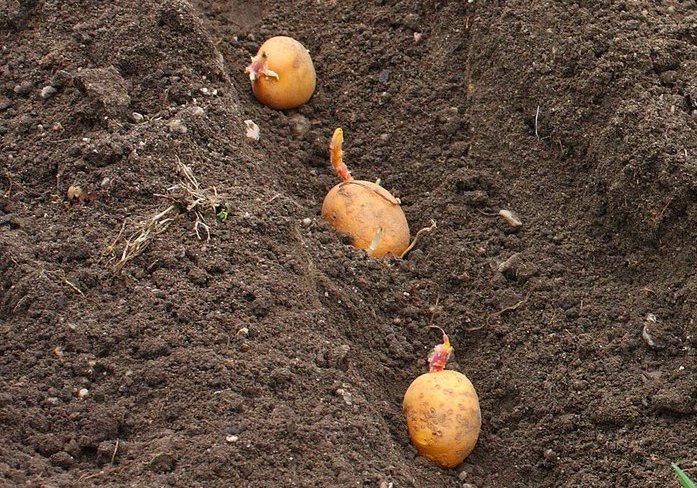 It is almost impossible to get a plentiful potato crop without using various top dressings, and observing all the rules for care. Therefore, properly selected fertilizer can be considered the key to a good harvest.
It is almost impossible to get a plentiful potato crop without using various top dressings, and observing all the rules for care. Therefore, properly selected fertilizer can be considered the key to a good harvest.
If you have no idea what kind of fertilizer is worth choosing - useful tips and secrets of gardeners will definitely help you with this. Potatoes are the main product on our tables. Therefore, many are interested in what kind of top dressing exists for him. Consider the main ones.
| Organic | Mineral | Rest |
|
Manure
Vegetable compost
Liquid bird droppings
Slurry
Siderata |
Phosphoric
Nitrogen
Potash
Integrated |
Ash wood
Bone meal
Lime |
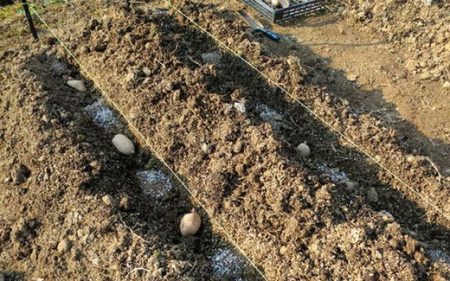
It is worth remembering that potatoes are a crop that will bring the maximum yield when it is properly fed at the very initial stage - when planting. It is fertilizer that will play the main role in the cultivation.
This is due to the fact that potato bushes very quickly absorb from the earth all the useful substances necessary for their development. That is, there should be plenty of them in the soil, otherwise the yield will be minimal.
Moreover, for 1 time it will not be possible to renew the deficit of nutrients. Therefore, you need to feed the bushes in 2 stages: under the autumn plowing, and directly into the hole before planting.
Content
More information about the types of fertilizing
Firstly, potatoes are in great need of organic fertilizers. So, it is best to make compost, bird droppings and manure.
Among mineral fertilizers, it is worth highlighting ammonium nitrate, urea, superphosphate and potassium. Phosphorus and nitrogen fertilizers also show good results.
Secondly, you should never fertilize potatoes with preparations that contain chlorine, nitrogen or calcium.
Mineral fertilizers
Among a huge number of all kinds of mineral fertilizers, potatoes are more in need of potash. The highest concentration of this substance in wood ash. Also, potatoes need to be fed with urea - urea.
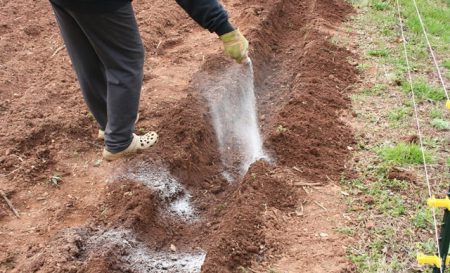
In addition to wood ash, gardeners recommend the use of potassium chloride with an amphibian. Nitrogen also plays an important role in the development of bushes. So, choosing the right dosage, you can get the most tall and powerful bushes. If this norm is exceeded, then not root systems, but leaf plates will grow.
Organics
As a rule, organic fertilizers have all the necessary ingredients for potatoes. Therefore, it is precisely these dressings that are considered the most significant. Organics are easily absorbed by plants, and contributes to the accumulation of humus and carbon dioxide in the earth, which allow the most powerful tubers to grow.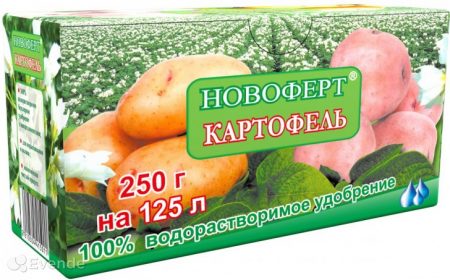
Such useful substances include rotted manure and fresh bird droppings. You can also use various options for compost waste of plant origin, and green manure.
Manure
It is necessary to bring it into the soil in advance, so that during the winter season the earth can be fully saturated with useful nutrients. This is done before plowing by scattering manure in the area from a consumption of 5-10 kg.for every square meter.
It is also worth remembering that under the potato bushes you can make exclusively dry rotted manure. This procedure is performed immediately before planting at the rate of 250 g of compost per well.
Chicken droppings are also an excellent solution among all organic fertilizers. It contributes to the rapid development of tubers. But, to bring it into the ground is in a diluted form, otherwise you can burn the root system of the bushes.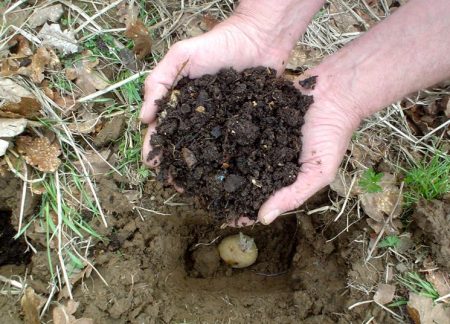
Litter is bred in water in a ratio of 1 to 10, and insisted for a couple of days in a warm place. Then the fertilizer of the bushes is made at the root, and the calculation of 1 liter. fluid on the bush.
Features of spring dressing
The most significant element for the growth of potato bushes should be considered nitrogen. Most of it is concentrated in wood ash and manure. At the same time, it is worth remembering that early varieties need more of these elements than later ones.
This is due to the fact that in early ripening potato varieties the shortest growing season, and plants simply can not manage to "absorb" all the necessary organic substances.
Mineral fertilizing has a much faster effect, and can give the bushes all the minerals needed for growth. That is, plants will receive them in exactly the amount that is needed.
During planting potatoes, you can use several types of mineral fertilizing:
- Potassium sulfate - 2 kg. per 100 square meters m .;
- Ammonium nitrate or double superphosphate - 1 kg. to "weave";
- 5 kg wood ash per 100 squares;
- Nitrofoska and complex fertilizers - 4 kg. per hectare.
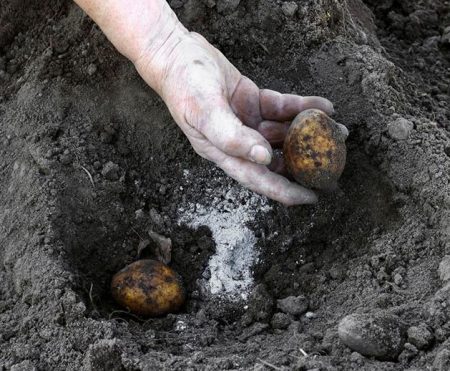
All substances listed above must be added directly to each hole, following the recommended standards. Liquid fertilizers need to be applied after the tops grow to 10 cm.
What fertilizers should be used when planting potatoes
According to the recommendations of experienced gardeners, it is best to add compost and manure, bone meal and wood ash, as well as various nutrients such as ammonium nitrate and carbamide with superphosphate.
What top dressing to apply in spring
Since potato roots can grow only in the upper soil layer, in spring, fertilizers must be applied directly to the pit with bushes. In this case, it is important to observe the dosage of the drugs.
If such feeding is carried out only on the surface of the earth, then all the tubers that grow first will simply turn green.
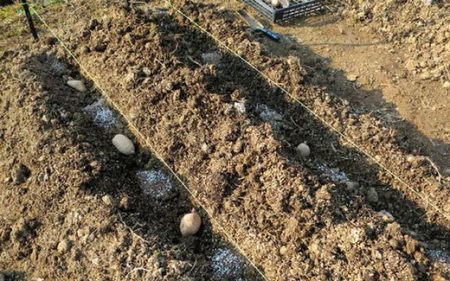
If the bushes are of medium size, and the soil is characterized by an average degree of fertility, then it is worth making no more than 2.5 kg. manure, and the same amount of phosphate and potash fertilizers.
In the case when the fertility of the earth is the lowest, it will be enough to make 100 kg into it. humus, and add 4 kg. superphosphate mixed with 1.5 kg. ammonium nitrate.
For example, if organic matter is chosen as fertilizer, then for each well with a seedling it will be necessary to use only 750 g of dry manure, and 200 g of wood ash. If mineral fertilizers are chosen, then it is worth taking 150 g of bone meal and 1 tbsp. l nitrofoski.
All substances purchased in an agricultural store must be brought in strictly in the quantity that is prescribed in the instructions.
What fertilizers to apply after planting potatoes
After planting, along with loosening and hilling the soil, you need to fertilize young bushes. So, in this period of development, they are most in need of nutrients. The first feeding is carried out in June-July.
As soon as the first buds appear, so that flowering occurs as soon as possible, you need to carry out the 2nd feeding. Used 1 tsp. potassium sulfate, 2.5 tbsp. l wood ash per square.
The last top dressing is carried out already at the stage of flowering bushes, and it is necessary for the early ripening of fruits. As a supplement, 2 tbsp. superphosphate for every 1 sq. m.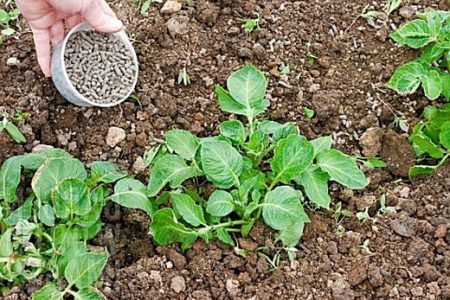
In the case when the growth of the bushes is slowed down, near each plant it is worth carefully watering the ground with infusion of mullein and bird droppings. It is important to ensure that the substance does not fall on the leaf plates of the bushes.
Root and foliar top dressing
Depending on the type of fertilizer, top dressing should be carried out by the root or extra-root method. The simplest option is to introduce substances under the root. The method is applied immediately after loosening the soil, so that nutritious feeding quickly reached the roots of the bush.
Both organic and inorganic substances are used for this procedure. Consider some of the subtleties of making such top dressings:
- Urea (1 tbsp) or urea also dissolves in a 10-liter bucket of water. This mixture is used for watering plants after cultivation, but before the first hilling;
- Mullein (which has already been fermented) is also suitable for watering bushes. It must be dissolved in an amount of 1 liter. for 10 liters water;
- An infusion of herbs is another feeding option that takes place in June. To carry out the procedure, it is necessary to soak a lot of weeds in water, wait until the waste is fermented, and water the plants around the perimeter of the pit.
Often gardeners use the so-called agrotechnical chemicals. For example, ammonium nitrate in the amount of 25 g per 10 liters. water, or a mixture of viburnum, nitrogen and phosphorus replenishment in a ratio of 1: 1: 2.
Since nutritious top dressing is necessary for potato bushes at all stages of development, a one-time addition of a substance may not give a positive result.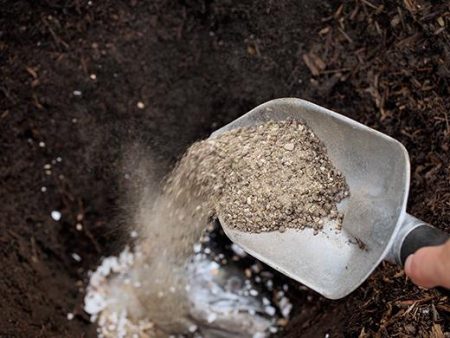
Therefore, gardeners use a foliar feeding system. It is carried out, as a rule, in the evening, so as not to injure or burn the plant. Although useful trace elements enter the plant at different speeds and through leaf plates, they still penetrate some parts of the top dressing faster than others.
It is important to always remember the state of the leaves. If they are healthy, they will be able to “deliver” microelements to the plant much faster than the diseased. In any case, it is best to use such top dressings as: nettle infusion, humates, and phosphoric, urea acid.
If the soil is sandy or sandy, then it is worth choosing nitrogen substances. For example, a mixture of urea in a small concentration. Further feeding will be carried out as follows:
- The first is done with a urea-based solution 2 weeks after the appearance of the first seedlings. Such a solution will include: potassium monophosphate (200 g.), Water (10 l.), Urea (150 g.) And boric acid (10 g.);
- This mixture is introduced in two stages, and diluted;
- Subsequent replenishment is made already undiluted solution with an interval of 14 days.
This will maximize the activation of all processes that occur in various plant systems, as well as increase its resistance to the most common diseases.
1 liter such a solution is taken 25 g of superphosphate, 3 g.potassium chloride and the same amount of ammonium nitrate, and 0.2 g of copper sulfate is also added. All this is mixed, infused for 4 hours, filtered to the required volume, and applied under the plant.
Phosphorus-based top dressing can significantly increase plant productivity and starch content in every potato. With this fertilizer, you can start spraying the bushes about 30 days before the planned harvest date.
In order for the fruits to be tasty, and so that voids do not form inside them, it is worth applying top dressing containing boron and manganese. They are introduced according to the foliar fertilizer scheme.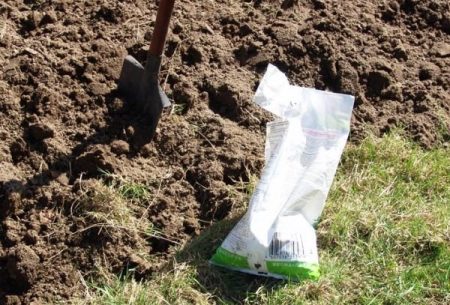
Humates are used to treat plants after at least 5 full leaves have appeared on them. Between treatments, pauses should be maintained for at least 14 days.
Gardeners who love natural fertilizers most of all prepare nettle infusion. To do this, the stems and leaves of the plant are filled with water and left to infuse in a warm place. After 10 days, the bushes can be treated with the solution.
How to make land
There are 3 methods of fertilizing the soil:
- Main;
- Sowing;
- As a fertilizer.
In the first method, recharge is added before cultivating the land, or immediately during cultivation before planting. Only by observing such a scheme, it is possible to achieve maximum plant nutrition.
When top dressing is applied simultaneously with planting, this method is called sowing.
By fertilizer is meant the addition of special nutritional mixtures to plants during the growing season. This procedure is carried out either in the spring or in the fall.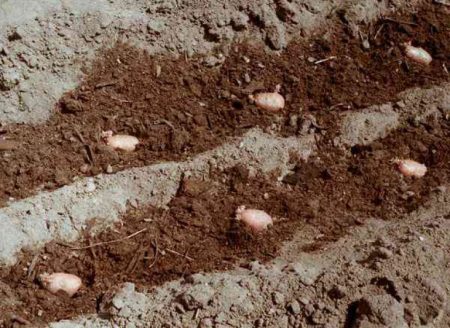
In late autumn, before the onset of the first cold weather, fresh manure, peat, and bird droppings are brought into the ground. In spring, fertilizer is carried out using humus, manure, and compost. It is best to add these elements to dry ground.
Inorganic types of fertilizing can be used at any time of the year. For example, nitrophoska is introduced during deep tillage in the fall, and if the soil is too heavy, nitroammophoska is used.
Ammophos is suitable as a liquid fertilizer. Used in spring. Such preparations are used either for spraying bushes, or are added to the hole before planting potato bushes.
Technology
It is immediately worth noting that all root dressings are carried out only in clear weather. This is due to some specific points that relate to photosynthesis.
Gardeners know that the root system of potato bushes develops in the upper layers of the soil. Therefore, all fertilizers that are applied directly to the wells, very quickly get to the bush.
Regarding foliar fertilizers. They are advised to spend in the evening, or in cloudy weather. After all, sunlight can provoke rapid drying of fertilizing, which will contribute to plant burns.
Moreover, spray the bushes gently at least 2-3 hours before the expected rainfall. This will allow the fertilizer to fully absorb.
The technology for applying inorganic potato fertilizers is as follows:
- For each well, it is always worthwhile to make 150-200 grams of wood ash in advance, and then fill it with soil;
- After the appearance of the first seedlings, the first fertilizer should be carried out with urea at the rate of 40 g per 20 liters. water. Pipette 500 ml. under each bush;
- The second top dressing is necessary for plants after the start of budding. To do this, take 25 g of potassium sulfate, dissolve in 15 liters. water, and add 25 g of wood ash. For each plant - 1 liter. solution;
- To tubers formed as quickly as possible, you need to feed the bushes with liquid mullein (300 g), and 2 tbsp. l superphosphate. All this needs to be insisted 30 minutes, and water the plant in a volume of 500 ml.
Correctly calculates the required fertilizer
The amount of fertilizer applied will depend on the fertility of the soil.If the soil is fertile, it is worth making 2-2.5 kg. superphosphate and manure, as well as up to 2 kg. potassium substances for every 100 square meters. m
If the soil has medium fertility, then we need more fertilizers. So, you have to make 3-4 kg. manure, the same amount of fertilizer based on nitrogen, 3 kg. potash, and 4.5 kg. phosphoric fertilizers.
In case the land is very depleted, we will need even more fertilizer. That is, it is necessary to make already 100 kg. manure, 1.5 kg. ammonium nitrate, and 3.5 kg. superphosphate fertilizers.
It is always worth remembering that an overabundance of nutrients will not do any good. Therefore, always strictly follow all recommendations regarding the amount of fertilizer applied.




 Description and description of varieties in Belarus with a photo
Description and description of varieties in Belarus with a photo Do I need to pick flowers from potatoes: why do they do it
Do I need to pick flowers from potatoes: why do they do it When to dig potatoes: timing and availability of new potatoes
When to dig potatoes: timing and availability of new potatoes How to grow a good potato crop: various methods and methods, planting and care
How to grow a good potato crop: various methods and methods, planting and care
Rusa
Good advice, thank you so much.